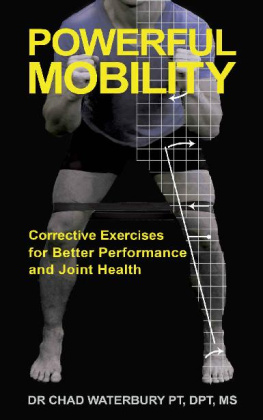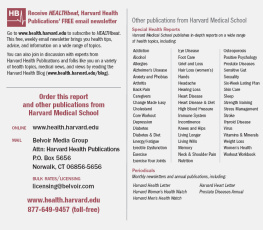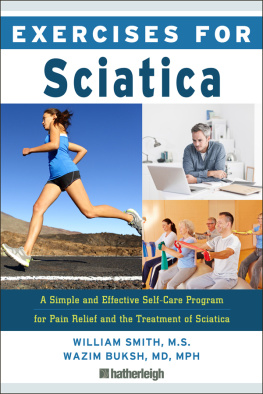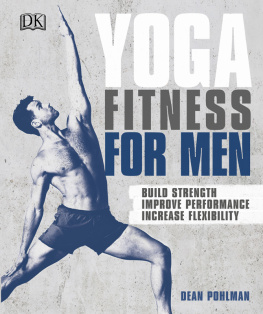POWERFUL MOBILITY
Corrective Exercises for Better Performance and Joint Health
DR CHAD WATERBURY PT, DPT, MS

If you want to find out more about Dr. Chad Waterbury visit: http://chadwaterbury.com
Published by Chad Waterbury LLC
ASIN: B075K1XWZP
NOTICE
The information in this book is meant to supplement, not replace, proper exercise training. All forms of exercise pose some inherent risks. The author advises readers to take full responsibility for their safety and know their limits. Before practicing the exercises in this book, be sure that your equipment is well maintained, and do not take risks beyond your level of experience, aptitude, training, and fitness. The exercises in this book are not intended as a substitute for any exercise routine that may have been prescribed by your doctor. As with all exercise programs, you should get your doctors approval before beginning.
2017 by Chad Waterbury LLC
All rights reserved. No part of this publication may be reproduced or transmitted in any form or by any means, electronic or mechanical, including photocopying, recording, or any other information storage and retrieval system, without the written permission of the author.
ACKNOWLEDGMENTS
Here I want to give a big thanks to all the people that have helped me become better at what I do. This book is possible because of their willingness to share the valuable information theyve learned over the years:
John Berardi, PhD
Ben Bruno
Mark Cheng, PhD
Bret Contreras, PhD
Gray Cook, PT
Eric Cressey
Sue Falsone, PT
Jason Ferruggia
International Sports Sciences Association
Craig Liebenson, DC
Stuart McGill, PhD
Christopher Powers, PhD
Lou Schuler
Trisha Smith, DC
Andreo Spina, DC
Pavel Tsatsouline
University of Southern California PT Dept.
Charlie Weingroff, DPT
START HERE
Dear Friend,
First of all, thank you for your purchase. Im confident this condense e-book will be a valuable tool for helping expand your corrective exercise knowledge base, and achieve better results with clients, patients, or your own training programs.
What you are about to read is just one of 13 chapters I wrote in a textbook for the Corrective Exercise Specialist certification course I created for the International Sports Sciences Association (ISSA). This 10-week online college course will help personal trainers, health care practitioners, massage therapists, and fitness buffs drastically increase their skillset and income stream.
If you enjoy the information presented in this e-book, I hope you will check out my Corrective Exercise Specialist certification course at:
http://issaonline.edu/certification/corrective-exercise-certification/

The great news is that, by purchasing this e-book, youre qualified to receive 10% off the Corrective Exercise Specialist course. To receive the discount, follow these simple steps:
Call the ISSA at 800-892-4772 and ask to speak to Frank Miele, or email Frank Miele at fmiele@issaonline.edu
Then, simply request the Waterbury Author discount and youll receive 10% off the Corrective Exercise Specialist course!
Cheers to your strength, health, and performance!
Dr. Chad Waterbury, PT, DPT, MS
Contents
WHAT YOU WILL LEARN
In this excerpt, taken from the Corrective Exercise Specialist certification course textbook, well look at the complex interplay between mobility and stability. Youll learn a set of corrective exercises that can produce far-reaching benefits from head to toe, and are appropriate for clients at all fitness levels.
ARE YOU OBSESSIVELY ASSESSING?
Some well-meaning personal trainers are fond of telling each other, If youre not assessing, youre guessing. The challenge, of course, is figuring out what to assess. Even the most knowledgeable physical therapists and clinicians dont agree on the answer.
Some experts believe that more emphasis should be put on a patients historyprevious injuries, job demands, exercise routines, etc. Others will spend more time on the individuals psychological state. Could that chronic stiffness on the left side of her neck and shoulder come from the fear of being hit by an abusive spouse, who just happens to be right handed? And some sports doctors will say they need to perform a long list of special tests for each joint, analyzing ligament integrity, muscle activation, and bony clearance, for starters.
These mixed messages filter down to personal trainers, who increasingly feel pressure to assess everything, even when they dont have the knowledge or skills to decipher all the information they accumulate. One consequence is a growing reliance on foam rolling and specialized stretches, which may be unnecessary and could even make a clients problem worse.
Fortunately, theres a lot you can do with corrective exercise to keep your clients moving safely and often, while leaving the more complicated tests to physical therapists, orthopedists, and, in some cases, psychiatrists.
WHAT TO DO FIRST?
Theres an ongoing debate about what to do first when a client is too stiff to move through a normal range of motion. It makes intuitive sense to have her perform stretches, foam rolling, and soft-tissue work to increase her range of motion. That would be both necessary and beneficial if the client had an injury that resulted in scar tissue and damage to the muscle and fascia.
Tissues that would be neatly aligned under normal circumstances can become distorted and misaligned after an injury, limiting the extensibility they need for optimal movement. Soft-tissue interventions, over weeks and months, allow them to reform in the correct alignment. (Remember that tissue changes usually take eight weeks or more.)
But stiffness doesnt always originate in the tissue. The nervous system will often create stiffness in a muscle as a protective mechanism. This protective tension is a common problem in healthy clients who dont have a recent injury.
To better understand why this happens, and what you can do to correct it, well start by discussing the relationship between mobility and stability.
Interplay Between Mobility and Stability
Optimal movement requires a hand-in-hand balance of mobility and stability. Mobility is achieved when the soft tissuesmuscles, fascia, joint capsuleshave the extensibility to allow the joints to move through a full range of motion, and theres no restriction imposed by the nervous system. This also includes the nerves themselves, since they must have the freedom to slide freely between the other soft tissues. The science and practice of nerve sliding during movement is known in rehabilitation circles as neurodynamics.
Stability is achieved when key muscles can contract at the precise time, and with enough force, to provide stiffness exactly where the body needs it.
Picture a client who can perform a full squat, with his hamstrings touching his calves, while standing on stable ground. What happens when he tries to do the same movement on a Bosu ball? Unless hes spent a lot of time practicing it, his range of motion is going to be much shorter. The nervous system reacts to the instability of the Bosu ball by limiting mobility. Its a protective mechanism.










